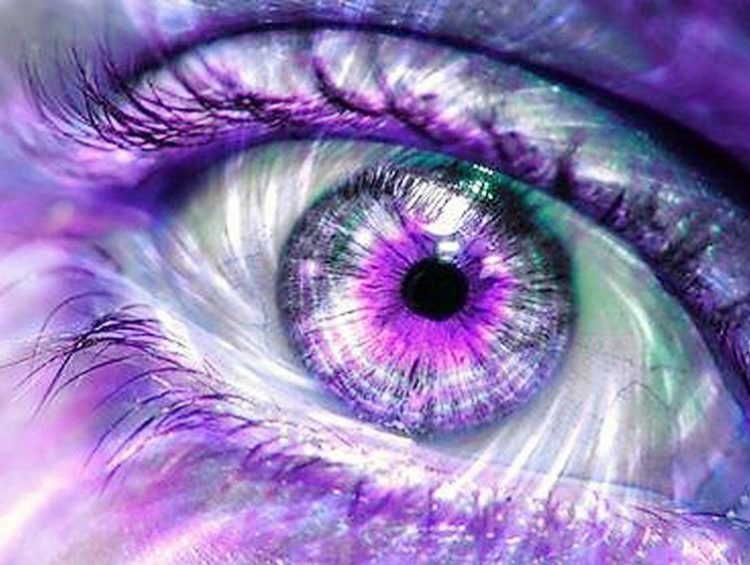The eyes are undoubtedly the windows to the soul, and if you know anything about windows or eyes, you are aware that they come in a variety of shades and colors!
When you look at people around you, you typically see brown, blue, or hazel eyes, but occasionally—whether by chance or due to a medical condition—you’ll come across someone with an extremely cool and uncommon eye color. Are purple eyes real? Do you have violet eyes, or do you know someone who does? Let’s investigate all the options.
Table of Contents
What Affects Your Eye Color?
However, there is still little known about the genes that determine a person’s eye color. Many people will assert that it is solely genetic, and it has been discovered to be true in most cases. We do know that recessive rare eye color genes exist, so perhaps the phenomenon can be caused by the combination of the genes of the appropriate two individuals.
Now, what we do know about how the iris scatters light and how it affects eye color is that it involves two pigments: melanin (brown pigment) and lipochrome (a yellow pigment). It indicates that there is no melanin, or brown pigmentation when someone has a light, blue eyes.
Can You Have Purple Eyes Naturally?
Absolutely, you can have naturally purple eyes. There are many different shades of blue and grey, as well as many colors in between. Even though it’s extremely uncommon, some people’s natural pigmentation can be violet or purple in hue.
You already know that the lighting in the room, your outfit, and your makeup can all affect how your eyes appear. Have there ever been times when putting on a new shirt made it seem as though your eyes were completely different? What if you saw your loved one standing outside in the sunshine with bright, joyful eyes? More light is reflected off of your eyes the lighter they are in color. With a simple change in clothing or lighting, you can definitely make your eyes look brighter, lighter, and more vibrant.
Are blue eyes a sign of inbreeding? It surprises me to say that the majority of Europeans with blue eyes seem to be fairly closely related. The DNA of the individual can reveal this to scientists.
Causes Of Purple Eyes
Heterochromaticism
Heterochromaticism refers to the different colors of each eye. For instance, one eye might be brown while the other is black. Uncertainty surrounds the cause of this.
Genetics
white people may have blue or gray eyes. Consequently, the baby’s eyes are likely to be gray or blue if the mother has gray eyes and the father has blue eyes.
Syndrome Of Fulminant Uveitis
fulminant uveitis syndrome is a condition of inflammation in different parts of the eye. According to experts, this circumstance may occasionally result in changes in eye color. Eye inflammation can cause blue or purple vision.
Melanin
When it comes to determining eye color, melanin is the real culprit. The main pigment in our eyes is what gives them the color they are. The color of the eyes darkens with melanin levels.
In contrast to people who are born with brown eyes, if you lack melanin in your iris, light splits into different colors, allowing your eyes to be green, hazel, blue, or even purple.
However, most people with purple eyes actually have eyes that are more of a violet hue. Furthermore, the red blood vessels in the iris of blue eyes can reflect light, giving the appearance of purple eyes.
Albinism
Some people have albinism disease, which may result in little to no melanin pigment in the iris, and it shows because they have purple eyes. When the eyes of people with blue eyes are damaged by the sun, blood vessels may appear and they may develop a purple appearance.
Fuchs Uveitis Syndrome
Inflammation of the eye’s uvea is a symptom of the condition known as Fuchs uveitis syndrome. This includes the iris as well as the ciliary body and choroid, two components of the eyes located behind the iris.
According to some experts, this inflammatory condition can change the color of the eyes, turning them blue or even purple.
Systemic lupus erythematosus, rheumatoid arthritis, sarcoidosis, and Behçet’s disease are a few autoimmune diseases that frequently contribute to the condition. Infections like syphilis and tuberculosis can also contribute to its development.
Eye Tumors
It has been established that eye tumors can alter the color of your eyes, even though having purple eyes is more of a stretch.
The iris of your eye’s tumer can develop inside or behind it. Most of these tumors are actually pigmented lesions known as nevi or cysts that resemble moles.
Eye color changes are frequently observed in nevi patients. Surgical and radiation treatments are available.
Waardenburg Syndrome
Deafness, as well as light skin, hair, and eyes, are all characteristics of the Waardenburg syndrome, a group of conditions that are typically passed down through families. Since the disorder is an autosomal dominant trait, only one parent needs to pass on the mutated gene for a child to develop it.
Waardenburg syndrome can be divided into four main subtypes, but types I and II are the most prevalent. While there is no known cure, there are treatments.

Do Elizabeth Taylor’s Purple Eyes Actually Exist?
This myth is widely believed. Due to the lighting, makeup, and attire Elizabeth Taylor was wearing, some photos made her eyes appear purple. Her eyes were actually blue, as seen in the vast majority of her photographs.
The Rarest Eye Colors & How They Occur
| Eye Color | Cause(s) |
|---|---|
| Black | A large amount of melanin |
| Red/Pink | Blood seeping into the iris and albinism |
| Amber | A small amount of melanin and a lot of lipochromes |
| Green | A small amount of melanin, a large number of lipochromes, and Rayleigh light scattering |
| Violet | Red blood vessels’ light-reflecting surfaces combined with a lack of pigment |
| Heterochromia | Increased or reduced iris pigmentation |
Conclusion
Purple eyes are real, but they are not a typical occurrence. There are many factors that can cause purple eyes. Levels of melanin in the iris determine eye color. People with more melanin typically have darker skin, hair, and eyes because melanin is a brown pigment.
Instead of being caused by a particular pigment, all eye colors other than brown are the result of a lack of melanin.
A lack of melanin prevents light from splitting into its various colors when it strikes the iris. The color of the eyes can be purple, blue, hazel, green, or other hues depending on the amount of melanin present.
Due to the additional factor of light reflecting off red blood vessels, some eyes appear purple rather than blue.
Read about Do Edibles Make Your Eyes Red?





